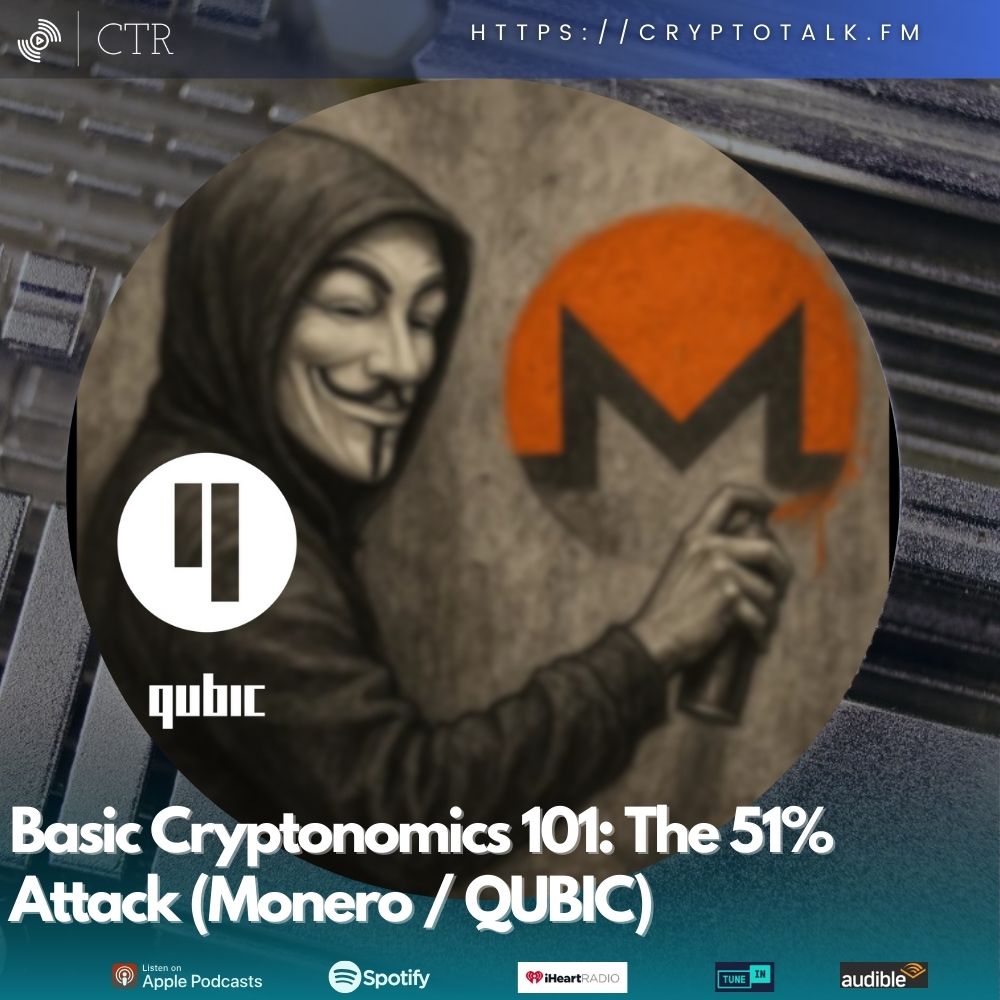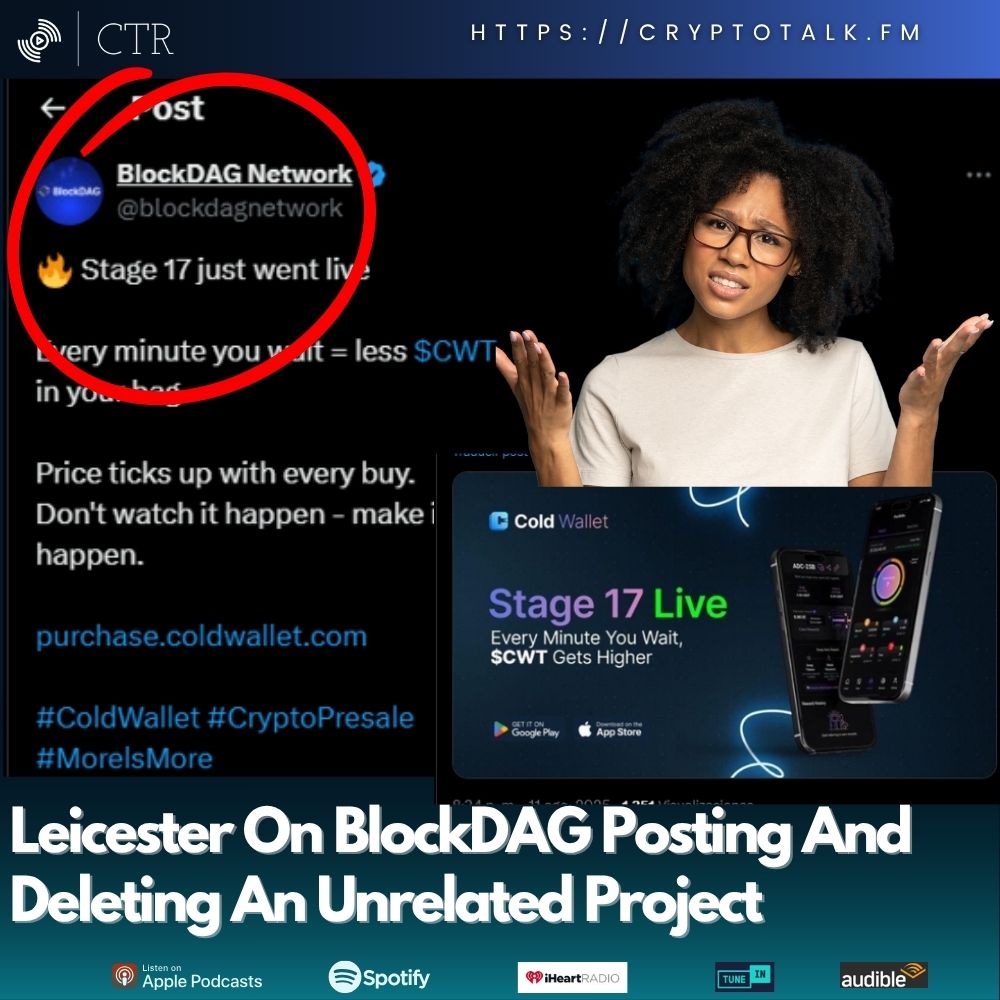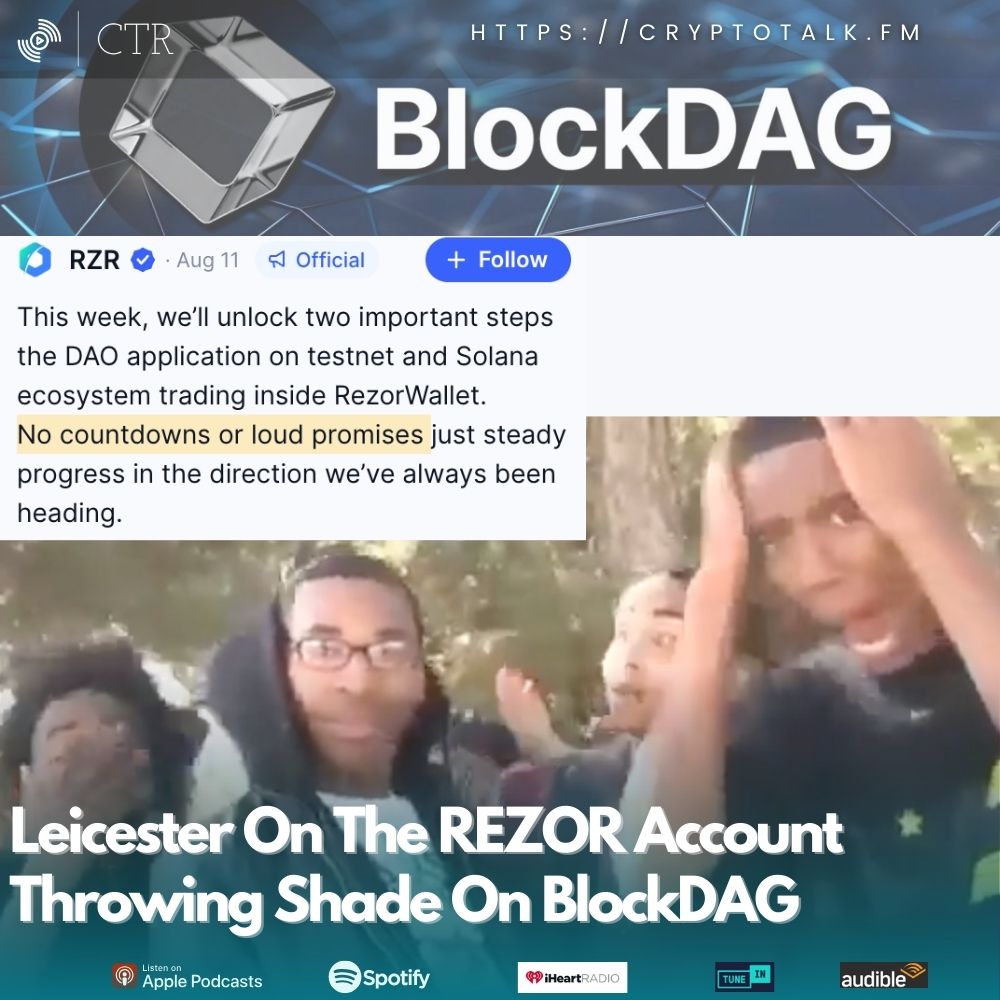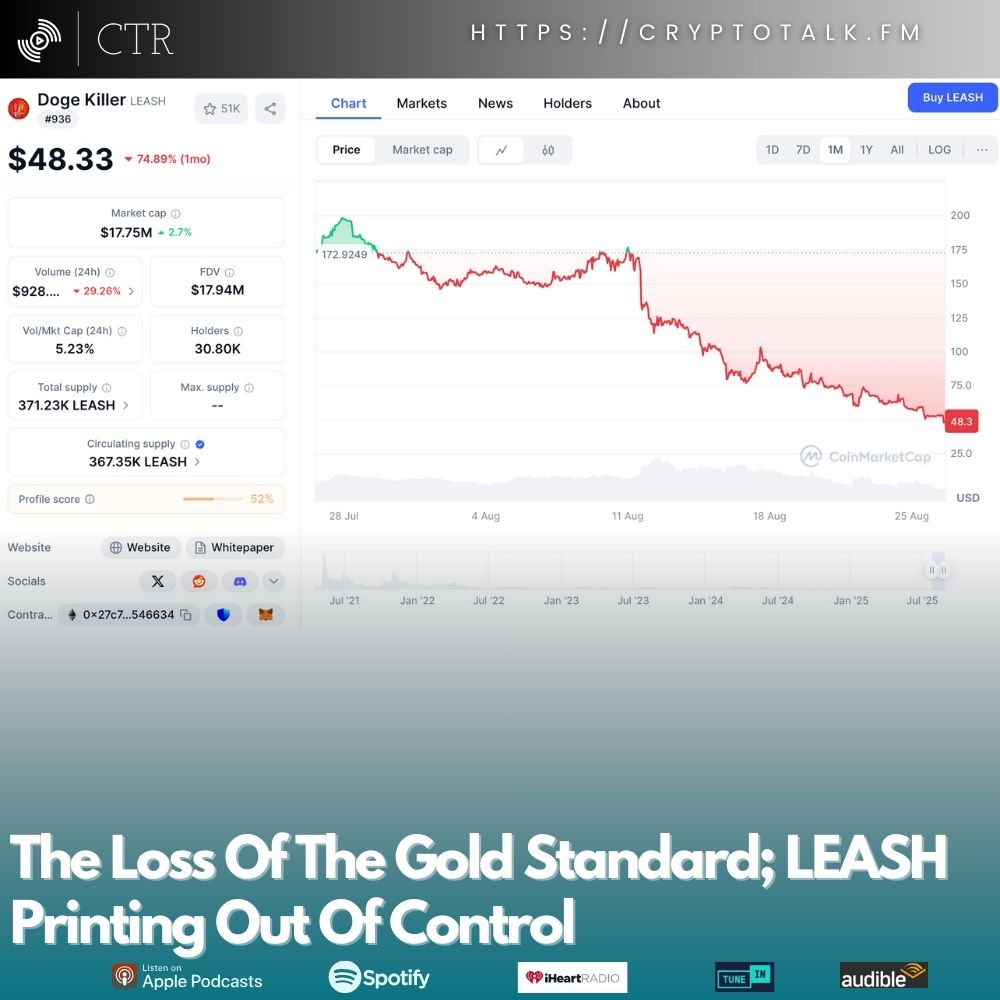[00:00:01] Welcome to Crypto Talk Radio, the podcast for everyday investors like you. Visit us on the
[email protected] and now here's your host, Leister.
[00:00:13] Thank you for that, Bailey. And welcome, everybody out there in Crypto Talk radio,
[email protected]. you know, I feel okay.
[00:00:22] I don't know if I feel okay. I don't know if I do. I'm kind of.
[00:00:25] I really. I actually debated saying, you know, skip the episode today, but the show must go on.
[00:00:33] It's nothing for you guys, trust me. I enjoy speaking with you. If you're new, welcome. It's not you guys. There's a lot going on. We have weird weather patterns and technical power business and Internet business and all sorts of chaos going. And then, of course, the student loan business, tax business. There's like everything hitting at once and it's annoying. The month of August is annoying.
[00:00:57] I wouldn't say it's like, I'm not nervous like I was in 2022 or nothing, but I'm just. There's all this stuff that's hitting. Unfortunately, I did a lot to kind of get ahead of most of it separately. You're like, well, what about Ethereum, though? Shouldn't you be excited? And I'm not, obviously, it's what I said was going to happen, but I'm noticing something that was unexpected. That's what I'm going to be mostly talking about today. Today will be a short episode, I think, because I'm going to talk about that. I'm going to talk about a couple other items that came up on Radar and Deccan.
[00:01:29] I think some other pieces I need to just breeze over just to mention them, just to have some ears on the product because there might be some people that listen to the longer episodes and skip the shorter episodes. And so I think there's value in sharing that information as well. Plus, this is going to replicate to YouTube, where there's a couple more people that are listening into the show. So I want to make sure I'm as thorough as I can be. But I also don't want to go too long. I try to keep them as short as I can sometimes. I got topics, but let's get into it. Let's get this out of the way.
[00:02:09] CoinDesk.com we're going to zoom out to the month chart and we're going to start, of course, with our favorite. That's Ethereum. Ethereum, of course, breaching the 4600 mark recently over the past 24 hours, a high of 4600. A low of 4200. Currently hovering just shy of 4600 with a strong upward trend. Corsi said Ethereum is the key to everything else. What I didn't expect is that everything else did not go up with the same percentage that I might have expected that they should. I'll get back to that here in a second. Let's talk about Bitcoin over the past 24 hours. Still at that 120,000 mark on the high end, a low of 118 grand on the low end, currently at the 120,000 mark, seeming like it wants to breach that upper limit.
[00:02:54] Some analysts looked at the data and they saw that pretty much 120k is the last point of immediate resistance for Bitcoin, meaning that there's a strong push upward expected if it can get past 120 grand. So some of the theory is that the current 120 grand is an artificial suppression, that there's an intent to prevent Bitcoin actively prevent Bitcoin from going to its next all time high.
[00:03:21] I think some estimates I saw for the next all time high for Bitcoin was somewhere around the $150,000 mark. Based on the percentages we saw on Ethereum, I would estimate probably 150,000, maybe 140,000 is about a fair number for the next target for Bitcoin. But I want you to notice something very specific, something I told you guys about.
[00:03:44] First of all, Ethereum still has not breached its all time high. The all time high for Ethereum is somewhere around 4800 bucks. It has not breached that. But the, the amount of climb, the velocity of climb on Ethereum was significant and substantial, irrespective of the fact that Bitcoin has been in the same range of 110 grand to 120 grand for an extended period of time, meaning that the price appreciation of Bitcoin is no longer directly correlated to the price appreciation of Ethereum and at the same ratio. And instead what we're seeing is that Ethereum is now appearing to stand on its own, on its own two legs. And then I look at all the other projects. Let's take Stellar XLM, only up roughly 3%.
[00:04:31] Only up roughly 5%. Bitcoin Cash only up 5%. 5% is about the good average for all of the other tokens and all the other blockchains. Well, why is it that with Ethereum going up so significantly that the other coins don't seem to want to go up at a significant pace like we would expect to do. And I think the answer is very simple. It has to do with the same thing that's hitting bitcoin, which is that they're not exceeding their all time high. And until they exceed their all time high, we're not seeing significant money flowing back in those other directions. So right now what we're seeing with the runs is just catching up to what was before. With bitcoin. It felt artificial. I said that before. It felt like it was. It's not that it's not, you can't make money. But it felt like it was an artificial suppression that something was holding it back, that something was stabilizing it at a certain price range, target possibly to avoid, you know, destruction on wrecked behavior, you know, getting liquidated. I don't know for sure, but it's the only explanation I've got for why bitcoin. Because by now bitcoin certainly should have breached that. It's been out there for ages and seems to not be able to breach the upper level and go to its new all time high. People still speculate it's going to happen here soon. Keep an eye on it, see what's going to happen. I don't know what the answer is going to be.
[00:05:51] Do Rug Pull, AKA Do Kwan, allegedly is going to plead guilty. He's pleading guilty on two of the charges. Facing 12 years in prison. There's a maximum of 25. But as they do when it's somebody who is of a celebrity status, they're going for the lower end of charges. It's not because of anything good that that Doe rug pull did. It's simply because it's a celebrity. And when it's a celebrity, understand that the government is just this US government is just trying to send a message. They're just trying to send a message to, hey, we can catch criminals. We could do all this stuff. They don't really. They're not serious about throwing the book at people like this.
[00:06:28] However you look at Bernie Madoff, they threw the book at that guy. And what did Bernie Madoff do? Bernie Madoff basically set up a glorified Ponzi scheme.
[00:06:37] And who was backing the Ponzi scheme? The big banks. The big. He. He even cut an interview before he died. And he was like, they had to know that this was going on. It's on the books. It's not like I was trying to hide it, but I'm the one sitting in jail and they get to go out free. That's the story Is, well, how come Bernie Madoff gets the book completely thrown at him because of what he was doing, but yet the banks get off Scot free, the CEOs get off Scot free. Wells Fargo, they were cramming people with a bunch of products that they didn't order.
[00:07:08] Left ways to Sunday. That guy went up in front of Congress and lied. Stump John Stumpf. And nothing happened. But okay, you got to pay a fine or whatever. This is what I'm saying that with what happens here and the sentence, and I'm not suggesting that the sentence should be aggressive, but I think that with the scale of what happened and the nature of the lies, which is really what's behind the charges that happen. Lies, fraud, et cetera. Around usdt.
[00:07:38] Considering how much money people lost, considering the fact that he lied. He lied about what was going on in the whole Tara ecosystem. He lied about that quote. Between 2018 and 2022 in the SDNY and elsewhere, I knowingly agreed to participate in a scheme to defraud purchasers of cryptocurrencies from my company, Terraform Labs. I made false statements about how the peg was restored and the role of another firm. I knew my statements were false. Stop.
[00:08:09] So what he's referring to is the idea and I told the brief story and I saw it on social media. It's been deleted since. But the backing story. And I've lost track of a lot of this because it's all essentially a pyramid. But essentially what happened is when it was peaking, the whole USDT and Terra UST at the time, rather when it was peaking in price, all of they started to see that there was going to be a risk on the peg, it was going to lose the peg on the Luna side. Terra side and Terra is pegged to ust. And they were. They have this synergistic relationship that I think is scam. But regardless of.
[00:08:52] So there's a risk of losing the peg. Allegedly DOE rug pull, AKA Do Kwon had reached out and I think it was jump crypto, but reached out to some organization who was gonna offer some bitcoin to buy over the counter to get some. I think it was UST at the time, but basically get some token of some. One of the two of them get some token in exchange for some bitcoin so that do rug pull could supplant the the store and the reserve and something happened. I remember the tweet, it talked something like, yeah, Do Doan took the bait and they took the tokens and they dumped off the project. And didn't get the bitcoin and some weird shady business and then do rug. Well that's where he's starting to lie. And that's when they were doing the, they did the vote and they talked about we, we want to fork it off to the Luna, which is the shiny Luna and do Terra Classic which became Luna Classic, which is the one that believe still shills to this day and that one. And then they did airdrops. They did airdrops based on what you held of the old Terra token for the new Luna to try to transition people away from it. And then doe rug pull started ducking the smoke and ran away from the cops. And it's a whole bit shady business. It's entirely possible I got some of those date points wrong because ultimately it was a, it was a developing situation. I remember the lengthy post because it came from. It was a picture that was snapped from Telescam that somebody was sharing about. And this was before we even knew what was going on. This is before all the data came out. But basically somebody on the inside, you know, spilled the beans about what do rug pull did with this org and basically got ripped off essentially and then triggered a rug pull because that person was able to dump off the tokens and drain the liquidity and then never recovered. And then of course the arbitrage between tokens triggered another cascading effect. And then of course because of the synergistic relationship, they were trying to balance each other out. And then of course, because of the minting function that's present as part of this, it was basically minting out of control. And so then the, the Luna Classic as it is started minting out of control. Ust was minting out of control. And so it gets to this whole chaotic nightmare and they finally, you know, other entities came in, they were talking about, you know, like terror rebels and all these of we can fix it, we can restore it. And it I'm not going to go deep point is that he was directly part and parcel and some people believes included were defending the guy. And I'm saying no, this is what he did. He lied. Bottom line, he's a fraudster. He's a rug puller, he's a scammer. That's what he is. He might have had the best of intentions in trying to buy the tokens, but he didn't talk to that, talk that through with the community. He rushed that vote and then he influenced it with some of the larger players to influence the vote in his favor to do the fork off because he wanted to run for the smoke. That's what happened. He didn't try to fix Luna Classic at all. He did later when they tried to bring him in. When he offered to do that, then the community said we don't want anything to do with this dude. We'll do it on our own. And then they started doing their chaos. Point is that the guy's a scammer and I'll call him Doe rug pull because that's what happened. He rug pulled the project. He, he did that. So I'm glad that he admitted his guilt and hopefully people will stop defending the guy. I hope that's the case. But people are not happy about the lower sentencing quote and this is this guy and I talked about this guy. He's kind of an idiot, but a fat man quote do Kwan's guilty plea means he'll most likely serve 15 to 20 years. Instead of the statuary max of 25. Prosecutors will recommend 12. This is some vindication after years of work. But make no mistake, Do Kwon is also becoming the fall guy for Jump Crypto. So that's the company that allegedly was doing the shady business of bitcoin and Kanav Kariya, which was apparently the guy who used to be an ahead of Jump Crypto as part of the court case. They were calling out things that have were obvious that the, you know, basically it's a. It's a glorified pyramid scheme. The there was no stability, there's no reserves. All this algorithmic chaos was doomed to fails. Kind of some of the case that was made that strengthened their argument against the guy. So remember and he ran. Right. He was ducking the smoke and believe said well that's because us is da da da. No, the point is he's a scammer. I mean that's really what it is. So I'm glad to see this happen. I'm glad to see that there's some justice happening and hopefully we get more justice from some of these scammers like him. I know that we won't, but hopefully that we do.
[00:13:18] Monero, which is xmr is currently having a little bit of smoke. This stems back years.
[00:13:24] So what happened? And I'm going to give the definition. It'll be my basic crypto promise. 101 today. I think that's a good idea. But I'll tell the story about what happened and I'll go into a little bit of deep details. Now I wasn't following it close. I just know that years ago this was a conversation that was happening, like, as far as I want to say, it was like 2021 where it first came up.
[00:13:46] So a company called Cubic and Cubic and. And if you didn't know Monero's proof of works, that's mining miners and Cubic recently hit the news because they were able to allegedly successfully execute what's called a 51% attack. I'll get into the details of what that is later. But again, this was rumored to be a risk on Monero years back, as far back as like 2021, that because of what's going on with Monero and because of its structure and everything else, that there was a risk of a 51 attack.
[00:14:19] And the conversation was going multiple times and some people were calling these people tinfoils and all this. And now we see that what they were saying was the truth and there was a strong risk. And nobody listened. Allegedly the mods went, or the devs rather went silent for a while on this one. And there was no conversation about how would, how do we mitigate this, how do we get ahead of it? The strongest way to mitigate it would have been to bump the hash rate. And I'll talk about that in a second.
[00:14:46] Nothing was done. And so as a result, then recently this guy from Cubic comes out and apparently he's well known in the community, comes out and says, you know, I've basically taken over 51% of your hash rate now, and I'm using it. I'm not gonna go any further on it, but I just want to let you know this is what happens, right?
[00:15:05] So let's talk about this whole 51% attack, okay? In proof of work, you have miners, you have people that mine, and you have mining pools and there's a hash rate.
[00:15:18] And a 51% attack says that you control or you are in control of 51 or more of the total hash rate for what's going on in the chain. And you might wonder, well, how does that happen? Well, it's very easy. It's about money time, right? But it's really money. If you got the money to do it, you and you can deploy enough mining infrastructure, enough mining machines, set up a building, set up the cooling, maybe do solar, wind, whatever you have to do to offset costs. But the one is, if you got enough money to throw at it, it's. And, and there's another key consideration. But if you got enough money to throw at it, you can set up a footprint that allows you to take a significant share of hash rate.
[00:16:01] Now, depending on the size of said chain.
[00:16:04] It's either easy or extremely difficult.
[00:16:07] Next to nigh impossible to do this 51% attack, say Bitcoin. It is next to impossible at this point of difficulty to do a 51% attack on Bitcoin. Like you wouldn't even think anybody could feasibly execute such an attack on Bitcoin. It's unthinkable. But some of these lesser chains, other layer ones, you know, et cetera, it's easier to do it because there's less demand, thus there's less cost, thus it's easier to do it. Monero is unique in one specific way that you might not have been aware of Monero.
[00:16:40] They purposely wrote the code to discourage, like strongly discourage. I don't want to say outright block, but strong make it difficult, right? Strongly discourage. ASIC machines, which AS six are used on Bitcoin because they're the only machines that are strong enough to mine Bitcoin and they're prohibitively expensive as a result.
[00:17:01] Monero took a different approach.
[00:17:03] They wrote the code in such a way to essentially enable and support cpu, as in the computer, you know, the heart and soul of your computer, that chip, that type of mining. Because what they were trying to do is they were trying to democratize mining as well as to ensure decentralization. Because if you didn't know, Monero is a privacy focused token, it always has been. And the thought was if you're allowing the ASIC machines and all that, that you are encouraging a form of centralization and you're defeating the purpose. But if you allow CPU mining, CPUs are less expensive by far. Even the strongest CPUs are less expensive than graphics cards. To put it in perspective, the RTX 5080, some odd, is over 1500 bucks, right? But you can get a really high end CPU processor for, you know, 5, 6, 700 bucks with Monero Mining on the CPU. You can still encourage people to get in with regular PCs that you already have, because most of them now have pretty decently strong CPUs inside of them because of saturation. There's so many out there that the price of CPUs has dropped significantly over years.
[00:18:16] So with as many as what they expected out there mining with the cpu, the thought was that it would help avoid the risk of 51% attack. The flaw of that thought process is Monero's very structure itself.
[00:18:32] It has been kicked off pretty much every exchange to date.
[00:18:36] I think there's a couple of still carry it, but the vast majority kicked it off the exchanges, there's not a lot of chatter about it, there's not a lot of hype about it. It doesn't have a lot of the same pressure behind it. You have all these garbage tokens that are spinning up mean tokens that are taking attention away from something like Monero and its value. Plus I actually had somebody listening on the show a while back that said I had some Monero and I don't know what to do with it and I don't know how to trade it. And I was telling them, here's a couple of ways that you might be able to consider doing it. But the point is that that's what I mean. It's so, it's so niche, it's so in the corner, it's so in the dark that people don't know exactly what to do with this thing that they have.
[00:19:16] As a result, there's no incentive, or at least the perception of incentive to mine it. Nobody sees value in holding it. Nobody sees value and they don't see profit potential. They don't see it's got a future.
[00:19:29] Despite being arguably one of two of the most privacy centric tokens out there. This attack though with Qubic creates the risk that somebody could then influence that, that privacy and basically breach people's privacy by intercepting the transactions, reverse engineer it to expose people's identities. It's a huge thing. And again, this has been talked about all the way back to 2021. So then nobody listened, right? Nobody listen. Here we are, fast forward, people are trying to figure out what the heck's going on.
[00:20:02] Cubic then has said, and they're not phrasing it like a threat, they're saying we're doing it. And this is the reason we're doing it, because we do mining for this, we take the rewards, we use it for our token, which is the cubic, I think it's called token. We use it for our token so that we can buy it and burn our token. And what we're doing is just to conceptually prove that even when you're a big player, you can influence the big player in order to benefit the small players. That's, that's this person's reasoning is we're not doing it to attack you, we're doing it to show and tell a message that, look, I don't care how big you are, all we have to do is get in the right position and we can use your token to benefit a lesser token. That's an intriguing thought process. This person's coming back because they're absolutely not wrong and it does set a scary precedent. Now some people claim that Cubic is lying and that ultimately, no, there is no way that they hit 51%. They do have a lot of the hash rate and yes, they could be, you know, disrupting the chain, but they did not hit the 51%. It's not a 51% attack.
[00:21:10] What they're saying is BS and don't listen to the news and don't hit everything and whatever that. Whatever, whatever, whatever.
[00:21:17] When people did the analysis, it turned out they did hit the 51% but could not sustain it. So the data, when you look at it, yes, for a brief moment they did hit 51% but enough came in other types of mining that disrupted it and took away the 51%. So here's the story on this. Does it affect you? Not yet.
[00:21:40] Will it affect you? Maybe if you hold Monero, it affected you from a price perspective and that's why. But the long game of this to be thinking about is with other cryptocurrencies, other types of tokens, we have to be very cognizant of this type of activity as tokens lose their popularity. So Shibarium is a great example. As tokens lose their popularity, we start seeing desperation. Desperation starts people down a path where they're going to influence some other chain to their advantage that may affect you. If that were to happen with Ethereum's recent run up, and I think Ethereum's run up is going to be sustained for a while, it's possible we see some of those garbage tokens spin up again like we did in 2021.
[00:22:25] If we start seeing run up of some of these other garbage tokens, it may entice some of these other people, these actors, to get in and take a significant amount of hash rate. For the ones that are proof of work that are still out there, then we might see some more garbage like the cubic basically poaching hash rate and liquidity and everything else to spin up for their project tokens. And that may affect you downstream, I guess. In summary, what I am suggesting, and again I wanted to just do that as a 101, I thought it was a good story to tell. But I guess what I'm saying as a call to action for the purpose of Monero, there's not really much you can do. For what we can tell, they did hit 51%. It didn't sustain, but it's high enough that there's still a concern. Okay, so that's. I'M not telling you to avoid Monero.
[00:23:15] I would say that if you have the capability to mine and you're interested in Monero, it's something to consider. I'm not going to do it myself primarily because my gaming PCs are toast.
[00:23:24] But if it is something of interest to you, that's something that you can do to help out. Get more people into mining is how you can do your part. If you're interested in Monero outside of that, then if you consider the circumstances that this was created from, we took a blockchain that was proof of work, that was substantial. Think like Ethereum Classic, right? Bitcoin gold, some of those.
[00:23:47] You take a blockchain and it's proof of work and it's established to a level. All of these are going to have positive run ups here soon. And Ethereum Classic most notably has been attacked 51% multiple times. So it's not unprecedented. This is not new. That's why I'm talking about it. Now.
[00:24:04] You take those chains, we have this run up happening off Ethereum. It is entirely possible that some of these types of attacks are going to be strong risks for these, meaning that they're going to experience significant dumps, especially if they are trading on exchanges because if they get access to significant of the tokens, they can just dump out the project, right? I'm not suggesting that it will happen, I'm saying that this is a strong risk given that we're seeing run ups from Ethereum and by way of Ethereum, all the other tokens are going to follow suit.
[00:24:35] In the short answer though, with Bitcoin notice, it still is in that middling range and Ethereum is right now the focus.
[00:24:43] Everything that's surrounding Ethereum, Avalanche and Polka Dot and Cardano, even Doge, all of these ones that are kind of around Ethereum are expected to have more runs. The runs are not substantial yet, but they're going to be. It's just a matter of time. If you are curious and just wondering, okay, what should be the buy strategy right now I can't answer that for you because you'll have to think about what it is that your priority is. If your priority is quick profit, Ethereum itself is not going to get you thick profit, it's not going to get you quick profit at all. But you can get quick profit from all the other tokens that are paired with Ethereum. So be looking on those and see because anything paired with Ethereum is going to have a strong run up. Pay close attention please. Don't throw more than you can afford to lose, though. Don't treat it like a casino. Some will. But please don't stay safe. Just keep. Be smart about it. That's all I say.






